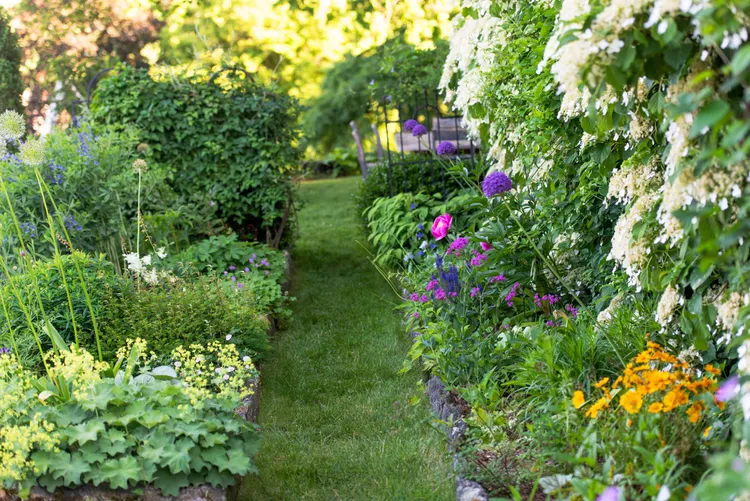Plant diseases are likely to make an appearance in just about any garden from time to time. Most are nothing to worry about and can be avoided or minimized by giving your plants the right care and choosing resistant varieties. Other diseases can mean game over, no matter what. It's essential to have a basic understanding of the plant diseases you're up against to decide how best to deal with them. Here's what you need to know about the most common plant diseases you'll likely encounter and how to prevent or treat them.
What Causes Plant Diseases?
Bacteria, viruses, and fungi cause most plant diseases by being transported to a vulnerable host, such as a stressed plant. Ideal conditions (e.g., humid, dry, or cloudy) allow the disease to develop.
Bacteria are single-celled organisms that live on various kinds of organic matter. Unable to survive in the open, bacteria live inside plants and are transferred plant to plant by insects, water, and hands. Fungi live on plants and cause visible symptoms. Viruses are the smallest of disease vectors and the most difficult to control. Insects typically spread plant viruses, but some are spread by infected tools and seeds.
1. Leaf Spots
Leaf spots are one of the most common symptoms of plant disease, whether caused by bacteria, fungi, or viruses. Other symptoms of these diseases include sudden wilting, ragged or curling leaves, deformed flowers or fruit, generally discolored or mottled foliage, and poor growth. For example, one type of leaf spot disease that is easy to identify is black spot, which causes dark splotches on leaves and leaf drop, mostly on roses.
Leaf spots tend to appear and spread during extended periods of wet weather. Provide good air circulation around plants to encourage foliage to dry quickly. Also, when watering plants, deliver water to the base of the plant, keeping the foliage as dry as possible. A drip system or a watering wand set on a gentle spray can help direct water just to the soil.
2. Mosaic Virus
Symptoms of mosaic virus include yellow or green mottled patterns on the infected leaves. Leaves may also be distorted, cupped, or curled. Peonies and other plants affected by this or other viruses should be destroyed to prevent the spread of this incurable plant disease. Avoid planting susceptible plants in the same spot.
3. Powdery Mildew
This fungal plant disease looks like a white powder on leaves and stems. It thrives during dry, humid weather, and can impact lots of different plants such as squash and lilacs. Prevent powdery mildew by choosing resistant plant varieties and spacing plants adequately during planting. Ample space between plants will allow for air circulation, discouraging the growth of powdery mildew.
4. Rose Rosette Disease
This viral plant disease is spread by a minuscule mite. Rose rosette disease cannot be prevented or cured. The best course of action is to remove infected rose plants as quickly as possible. Symptoms include thick, reddish new stems with many times the normal number of thorns. There is often a large flush of growth at the end of the infected stems.
5. Rust
Rust is caused by several fungus species that each have specific plant hosts (for example, cedar-apple rust only attacks apple trees and plants in the cedar family but needs both species to complete its life cycle). Rust appears on leaves as orange, gold, or brown-red spots. This disease mostly just looks bad and doesn't cause lasting harm to the plant. Give susceptible plants proper care and they should naturally overcome a rust outbreak.
How to Prevent Plant Diseases
Preventing pathogens from getting a foothold in the first place is the best defense. Smart disease-prevention strategies include:
- Selecting disease-resistant plant varieties.
- Placing plants far enough apart to allow air to circulate freely, which helps dry leaves more quickly.
- Properly caring for susceptible plants (growing them in the recommended amount of sun, keeping them well watered, and not over- or underfertilizing them).
- Regularly treating healthy leaves of susceptible plants with a homemade fungicide made by combining 1 teaspoon of baking soda and 1 teaspoon of horticultural oil in a quart of water.
- Removing diseased plant parts or the entire plant as soon as possible.
- Never adding diseased plants to your compost pile, which may not get hot enough to kill pathogens.
Get Rid of Insects on Your Plants
Some plants are more susceptible to specific insect infestations than others. Tomato hornworms can destroy your crop, so knowing how to identify and eliminate these pests is helpful. Aphids are a common problem exacerbated by poor soil or plant overcrowding. Add ladybugs to your garden to help control them. If you spot an army of ants climbing on your citrus trees, here's what to do to get rid of them (though they won't do any damage). Insects are always present in a garden—knowing the difference between beneficial ones and those that cause damage is essential.




















